Class SimpleSurfaceDataImpression
A "Surfaces" data impression that uses hand-drawn textures and color to show surface data.
Inheritance
Namespace: IVLab.ABREngine
Assembly: IVLab.ABREngine.Runtime.dll
Syntax
[ABRPlateType("Surfaces")]
public class SimpleSurfaceDataImpression : DataImpression, IHasDataset, IHasKeyData, ICoordSpaceConverterExamples
An example of creating a single surface data impression and setting its colormap, color variable, and texture could be:
SimpleSurfaceDataImpression gi = new SimpleSurfaceDataImpression();
gi.keyData = surfs;
gi.colorVariable = yAxis;
gi.colormap = ABREngine.Instance.VisAssets.GetDefault<ColormapVisAsset>() as ColormapVisAsset;
gi.lineTexture = tex;
ABREngine.Instance.RegisterDataImpression(gi);Constructors
| Improve this Doc View SourceSimpleSurfaceDataImpression()
A "Surfaces" data impression that uses hand-drawn textures and color to show surface data.
Declaration
protected SimpleSurfaceDataImpression()Examples
An example of creating a single surface data impression and setting its colormap, color variable, and texture could be:
SimpleSurfaceDataImpression gi = new SimpleSurfaceDataImpression();
gi.keyData = surfs;
gi.colorVariable = yAxis;
gi.colormap = ABREngine.Instance.VisAssets.GetDefault<ColormapVisAsset>() as ColormapVisAsset;
gi.lineTexture = tex;
ABREngine.Instance.RegisterDataImpression(gi);Fields
| Improve this Doc View SourceLayerName
Define the layer name for this Data Impression
Declaration
protected const string LayerName = "ABR_Surface"Field Value
| Type | Description |
|---|---|
| string |
Remarks
Warning
New Data Impressions should define a const string "LayerName" which corresponds to a Layer in Unity's Layer manager.
colorVariable
Scalar color variable applied to each point of this data impression. This example switches between X-axis monotonically increasing and Y-axis monotonically increasing.
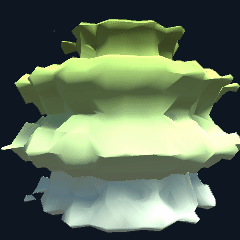
Declaration
[ABRInput("Color Variable", UpdateLevel.Style)]
public ScalarDataVariable colorVariableField Value
| Type | Description |
|---|---|
| ScalarDataVariable |
colormap
Colormap applied to the colorVariable. This example switches between a linear white-to-green colormap and a linear black-to-white colormap.
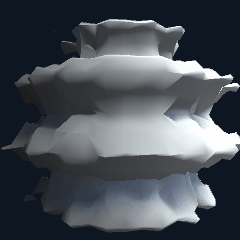
Declaration
[ABRInput("Colormap", UpdateLevel.Style)]
public IColormapVisAsset colormapField Value
| Type | Description |
|---|---|
| IColormapVisAsset |
keyData
A "Surfaces" data impression that uses hand-drawn textures and color to show surface data.
Declaration
[ABRInput("Key Data", UpdateLevel.Geometry)]
public KeyData keyDataField Value
| Type | Description |
|---|---|
| KeyData |
Examples
An example of creating a single surface data impression and setting its colormap, color variable, and texture could be:
SimpleSurfaceDataImpression gi = new SimpleSurfaceDataImpression();
gi.keyData = surfs;
gi.colorVariable = yAxis;
gi.colormap = ABREngine.Instance.VisAssets.GetDefault<ColormapVisAsset>() as ColormapVisAsset;
gi.lineTexture = tex;
ABREngine.Instance.RegisterDataImpression(gi);nanColor
Override the color used for NaN values in this data impression. If not supplied, will use the defaultNanColor.
Declaration
[ABRInput("NaN Color", UpdateLevel.Style)]
public IColormapVisAsset nanColorField Value
| Type | Description |
|---|---|
| IColormapVisAsset |
nanPattern
Override the pattern/texture used for NaN values in this data impression. If not supplied, will use the defaultNanTexture.
Declaration
[ABRInput("NaN Pattern", UpdateLevel.Style)]
public ISurfaceTextureVisAsset nanPatternField Value
| Type | Description |
|---|---|
| ISurfaceTextureVisAsset |
onlyOutline
ONLY show the outline (don't show the actual surface)
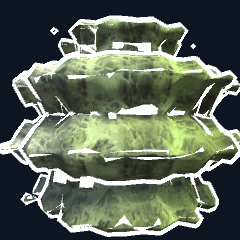
Declaration
[ABRInput("Show Only Outline", UpdateLevel.Style)]
public BooleanPrimitive onlyOutlineField Value
| Type | Description |
|---|---|
| BooleanPrimitive |
opacity
Opacity of the surface - how see-through the surface is.
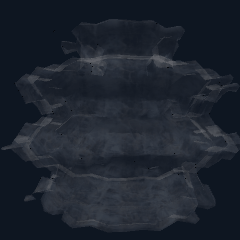
Declaration
[ABRInput("Opacity", UpdateLevel.Style)]
public PercentPrimitive opacityField Value
| Type | Description |
|---|---|
| PercentPrimitive |
outlineColor
Color of the outline
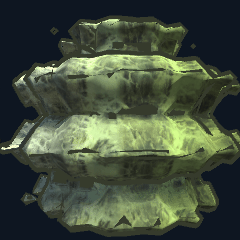
Declaration
[ABRInput("Outline Color", UpdateLevel.Style)]
public IColormapVisAsset outlineColorField Value
| Type | Description |
|---|---|
| IColormapVisAsset |
outlineWidth
Width (in Unity world coords) of the outline
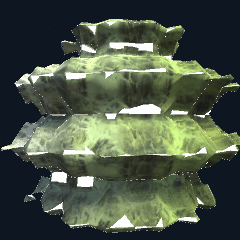
Declaration
[ABRInput("Outline Width", UpdateLevel.Style)]
public LengthPrimitive outlineWidthField Value
| Type | Description |
|---|---|
| LengthPrimitive |
pattern
The pattern/texture applied to the surface - can also be a SurfaceTextureGradient.
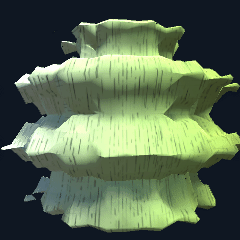
Declaration
[ABRInput("Pattern", UpdateLevel.Style)]
public ISurfaceTextureVisAsset patternField Value
| Type | Description |
|---|---|
| ISurfaceTextureVisAsset |
patternIntensity
Edit the intensity which the pattern is overlaid on the surface. 0% is not present at all, 10% is very faint, and 100% is full overlay.
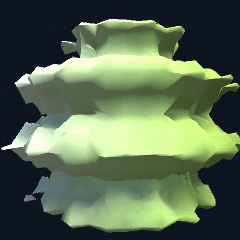
Declaration
[ABRInput("Pattern Intensity", UpdateLevel.Style)]
public PercentPrimitive patternIntensityField Value
| Type | Description |
|---|---|
| PercentPrimitive |
patternSaturation
Edit the saturation of the pattern(s) - 100% is full color, 0% is full grayscale.
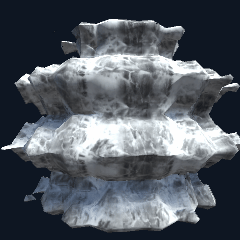
Declaration
[ABRInput("Pattern Saturation", UpdateLevel.Style)]
public PercentPrimitive patternSaturationField Value
| Type | Description |
|---|---|
| PercentPrimitive |
patternSeamBlend
Percentage to "blend" textures together at the seams to minimize the tiling effect. This example goes from 0% seam blend to 20% seam blend.
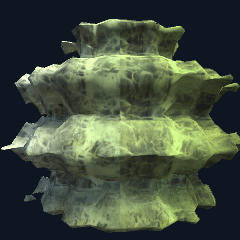
Declaration
[ABRInput("Pattern Seam Blend", UpdateLevel.Style)]
public PercentPrimitive patternSeamBlendField Value
| Type | Description |
|---|---|
| PercentPrimitive |
patternSize
How large, in Unity meters, to make each "tile" of the texture/pattern on the surface. This example goes from 0.5m to 1m.
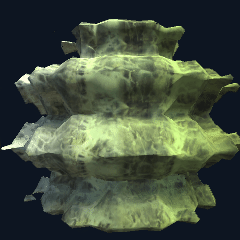
Declaration
[ABRInput("Pattern Size", UpdateLevel.Style)]
public LengthPrimitive patternSizeField Value
| Type | Description |
|---|---|
| LengthPrimitive |
patternVariable
Scalar variable used to vary the pattern across the surface.
Declaration
[ABRInput("Pattern Variable", UpdateLevel.Style)]
public ScalarDataVariable patternVariableField Value
| Type | Description |
|---|---|
| ScalarDataVariable |
showOutline
Show/hide outline on this data impression (show the outline AND the actual surface)
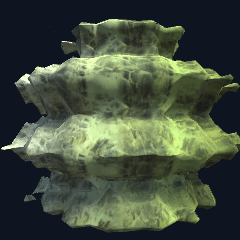
Declaration
[ABRInput("Show Outline", UpdateLevel.Style)]
public BooleanPrimitive showOutlineField Value
| Type | Description |
|---|---|
| BooleanPrimitive |
Remarks
NOTE: Outlines work best on convex objects. The wavelet in this example shows some artifacts due to its concavity.
Properties
| Improve this Doc View SourceMaterialNames
Name of the material to use to render this DataImpression
Declaration
protected override string[] MaterialNames { get; }Property Value
| Type | Description |
|---|---|
| string[] |
Overrides
Methods
| Improve this Doc View SourceComputeGeometry()
RENDERING STEP 1. Populate rendering information (Geometry) for the DataImpression. This is triggered by the DataImpressionGroup when an Geometry happens. This step is generally expensive.
Declaration
public override void ComputeGeometry()Overrides
| Improve this Doc View SourceGetDataset()
By default, there's no dataset. DataImpressions should only have one dataset, and it's up to them individually to enforce that they correctly implement this.
Declaration
public override Dataset GetDataset()Returns
| Type | Description |
|---|---|
| Dataset |
Overrides
| Improve this Doc View SourceGetKeyData()
By default, there's no data. DataImpressions should only have one KeyData, and it's up to them individually to enforce that they correctly implement this.
Declaration
public override KeyData GetKeyData()Returns
| Type | Description |
|---|---|
| KeyData |
Overrides
| Improve this Doc View SourceGetKeyDataTopology()
By default, there's no data. DataImpressions should only have one KeyData, and it's up to them individually to enforce that they correctly implement this.
Declaration
public override DataTopology GetKeyDataTopology()Returns
| Type | Description |
|---|---|
| DataTopology |
Overrides
| Improve this Doc View SourceSetKeyData(KeyData)
By default, there's no data. DataImpressions should only have one KeyData, and it's up to them individually to enforce that they correctly implement this.
Declaration
public override void SetKeyData(KeyData kd)Parameters
| Type | Name | Description |
|---|---|---|
| KeyData | kd |
Overrides
| Improve this Doc View SourceSetupGameObject()
RENDERING STEP 2. Take geometric rendering information computed in ComputeGeometry() and sets up proper game object(s) and components for this Data Impression. Transfers geometry into Unity format (e.g. a Mesh). No geometric computations should happen in this method, and it should generally be lightweight.
Declaration
public override void SetupGameObject()Overrides
| Improve this Doc View SourceUpdateStyling()
RENDERING STEP 3. Update the "styling" of an impression by sending each styling parameter to the shader. Occasionally will need to set per-vertex items like transforms. This method should generally be lightweight.
Declaration
public override void UpdateStyling()Overrides
| Improve this Doc View SourceUpdateVisibility()
RENDERING STEP 4. Update the visibility of an impression (hidden or shown)
Declaration
public override void UpdateVisibility()